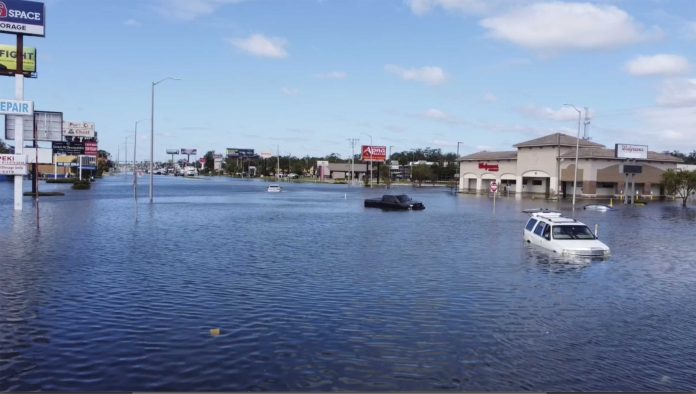
By JULIO CORTEZ, KATE PAYNE and HAVEN DALEY
Associated Press
ST. PETERSBURG, Fla. (AP) — Hundreds of Florida residents were rescued Thursday from the aftermath of Hurricane Milton after the storm smashed through coastal communities where it tore homes into pieces, filled streets with mud and spawned a barrage of tornadoes that killed at least five.
Arriving just two weeks after the misery wrought by Hurricane Helene, the system also knocked out power to more than 3 million customers, flooded barrier islands, tore the roof off a baseball stadium and toppled a construction crane.
But many people also expressed relief that Milton wasn’t worse. The hurricane spared Tampa a direct hit, and the lethal storm surge that scientists feared never materialized.
The storm tracked to the south in the final hours and made landfall late Wednesday as a Category 3 hurricane in Siesta Key, about 70 miles (112 kilometers) south of Tampa. Damage was widespread, and water levels may continue to rise for days, but Gov. Ron DeSantis said it was not “the worst-case scenario.”
“You face two hurricanes in a couple of weeks — not easy to go through — but I’ve seen a lot of resilience throughout this state,” the governor said at a briefing in Sarasota. He said he was “very confident that this area is going to bounce back very, very quickly.”
South of Tampa, Natasha Shannon and her husband, Terry, felt lucky to be alive after the hurricane peeled the tin roof off their cinder block home in Palmetto. They spent the night in a shelter with their three children and two grandchildren after she pushed them to leave.
“I said, ‘Baby, we got to go. Because we’re not going to survive this,'” she said.
They returned to find the roof torn into sheets across the street, shredded insulation hanging from exposed ceiling beams and their belongings soaked.
“It ain’t much but it was ours,” she said. “What little bit we did have is gone.”
The worst storm surge appeared to be in Sarasota County, where it was 8 to 10 feet (2.5 to 3 meters) — lower than in the worst place during Helene. The storm also dumped up to 18 inches (45 centimeters) of rain in some areas.
At least 340 individuals and 49 pets have been rescued in ongoing search-and-rescue operations, DeSantis said Thursday afternoon.
After flying over some of the hard-hit areas, the governor said many of the homes that went up in recent years withstood the storm: “Our buildings that were built in the last 20 or 30 years, they did very well.”
Officials in the hard-hit Florida counties of Hillsborough, Pinellas, Sarasota and Lee urged people to stay home, warning of downed power lines, trees in roads, blocked bridges and flooding.
Just inland from Tampa, the flooding in Plant City was “absolutely staggering,” according to City Manager Bill McDaniel, who estimated the city received 13.5 inches (34 cm) of rain.
“We have flooding in places and to levels that I’ve never seen, and I’ve lived in this community for my entire life,” he said in a video posted online Thursday morning.
The tiny barrier island of Matlacha, just off Fort Myers, got hit by both a tornado and a surge, with many of the colorful buildings in the fishing and tourist village sustaining serious damage. Tom Reynolds, 90, spent the morning sweeping out four feet of mud and water and collecting chunks of aluminum siding torn off by a twister that also picked up a car and threw it across the road.
Elsewhere on the island, a house was blown into a street, temporarily blocking it. Some structures caught fire. Reynolds said he planned to repair the home he built three decades ago.
“What else am I going to do?” he said.
In contrast, city workers on Anna Maria Island were grateful not to be wading through floodwaters as they picked up debris Thursday morning, two weeks after Helene battered buildings and blew in piles of sand up to 6 feet (1.8 m) high. Those piles may have helped shield homes from further damage, said Jeremi Roberts of the State Emergency Response Team.
“I’m shocked it’s not more,” city worker Kati Sands said as she cleared the streets of siding and broken lights. “We lost so much with Helene, there wasn’t much left.”
The storm slammed into a region still reeling from Helene, which flooded streets and homes in western Florida and left at least 230 people dead across the South. In many places along the coast, municipalities raced to collect and dispose of debris before Milton’s winds and storm surge could toss it around and compound any damage.
Power was knocked out across much of the state, with more than 3.4 million homes and businesses without electricity, according to poweroutage.us, which tracks utility reports.
The fabric that serves as the roof of Tropicana Field — home of the Tampa Bay Rays baseball team in St. Petersburg — was ripped to shreds by fierce winds. Debris littered the field, but no injuries were reported.
Jessie Schaper, a meteorologist with the National Weather Service in Melbourne, Florida, said it was too early to know exactly how many tornadoes touched down or how strong they were.
The five tornado deaths happened in the Spanish Lakes Country Club near Fort Pierce, on Florida’s Atlantic Coast, where homes were destroyed, authorities said.
Speaking at a White House briefing, Homeland Security Secretary Alejandro Mayorkas said there were reports of as many as 10 fatalities from tornadoes, but he cautioned that the number was tentative.
By Thursday afternoon, Milton was headed into the Atlantic Ocean as a post-tropical cyclone with winds of 75 mph (120 kph) — just barely hurricane force.
Officials had issued dire warnings to flee or face grim odds of survival.
Jackie Curnick said she wrestled with her decision to stay at home in Sarasota, just north of where the storm made landfall. She and her husband started packing Monday to evacuate, but they struggled to find available hotel rooms, and the few they came by were too expensive.
With a 2-year-old son and a baby girl due Oct. 29, Curnick said there were too many unanswered questions if they got in the car and left: Where would they sleep? Would they be able to fill their gas tank? And could they even find a safe route out of the state?
Video taken during the storm showed howling winds and sheets of rain lashing their glass-enclosed swimming pool as their son and dog watched. Trees shook violently.
On Thursday morning, she reported that the family was without power but safe.
About 80,000 people spent the night in shelters and thousands of others fled after authorities issued mandatory evacuation orders across 15 Florida counties with a total population of about 7.2 million people.
Crossing the bridge from the mainland to Anna Maria Island early Thursday, Police Chief John Cosby breathed a sigh of relief. Nearly all residents had evacuated. There were no injuries or deaths, and the projected storm surge never happened. After fearing that his police department would be underwater, it remained dry.
“It’s nice to have a place to come back to,” he said.



















